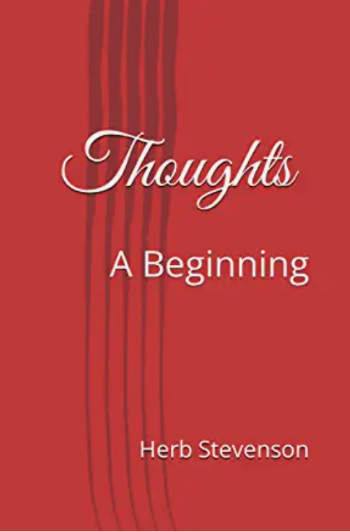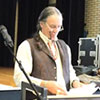

A book by Herb Stevenson, Volume 1. Learn more on Amazon.
Thoughts II:
The Next Step: A Calling

Volume 2 of 3. Learn more on Amazon.
Thoughts III:
Creating The Container

Volume 3 of 3. Learn more on Amazon.
To Lead
Read the article about training with Herb Stevenson in ALN Magazine.
See the article...
Visioning as an
Emergent Process
Visioning as an Emergent process can bring about meaningful insights leading to cultural shifts to an entire organization. This includes new understanding and cooperation while strengthening the organization as a unified team. It involves the representation of the whole organization, meeting and working together in one place, at the same time. Our consultants are trained and certified in a wide range of methods to provide Visioning as an emergent process. We support your creation of the organization’s vision, mission, and guiding principles. When you work with us, we develop a customized program together based on these methods:
"Emergent change processes engage the diverse people of a system in focused yet open interactions that lead to unexpected and lasting shifts in perspective and behavior." —Peggy Holman
Planned Versus Emergent Processes
To provide perspective, visioning often is deliberate, a product of conscious reasoning and actions which is commonly referred to as planned future. In contrast, visioning sometimes unfolds in an apparently spontaneous and unplanned way. This is known as emergent processes.
| Planned Vision | Emergent Vision |
|
|
Besides the above characteristics, there is a deeper distinction that bears revealing. Managers make a number of decisions commonly unrelated to the vision, mission, and guiding principles that emerges. The vision is therefore not planned. However, these decisions may be based on unspoken, and sometimes unconscious, assumptions about the organization, its environment and the future (Mintzberg, 1989). Such implicit assumptions dictate the direction of the seemingly disparate and unrelated decisions, thereby shaping the organization by 'drift' rather than by design.
External factors (such as the economy, competitors' behavior, and political climate) or internal features (such as the relative power of different interest groups, distribution of knowledge, and uncertainty) influence the organization directions outside the control of managers. Even the most carefully planned and executed visioning process will have some emergent impacts. This highlights two important aspects.
- The need to identify, explore and if necessary challenge the assumptions that underlie decisions.
- An important message is that visioning is not fixed or linear in nature but contains an important emergent element.
Not for the faint hearted.
Insanity: doing the same thing over and over again and expecting different results. —Albert Einstein
Emergence as a process is order arising out of chaos. For many organizations, to even acknowledge that they have a hidden chaos that seems to be preventing them from being more effective is taboo. Emergent visioning tests the executive maturity level of the organization to even consider that higher-order complexity arising out of chaos in which novel, coherent structures coalesce through interactions among the diverse entities of a system is a worthwhile pursuit. For them, visioning as an emergent process resembles insanity. Yet, how many executives continue to practice the very definition of insanity by using the same behavior and logic over and over again while expecting a different outcome. Emergence occurs when the individual, team, and organization interactions disrupt, causing the system to differentiate and ultimately coalesce into something new and different.
Evolution of Emergent Change
Through the revolutionary approaches by Social scientists Fred Emery and Eric Trist who created a "Search Conference" and Consultants Kathleen Dannemiller, Chuck Tyson, Alan Davenport, and Bruce Gibb who created Large Scale Change they laid the groundwork to a completely different approach to visioning. Visioning as an Emergent process became a critical aspect of organization change and development by (1) working with the whole system, and (2) involving the people of that system in finding their own answers. In short, it became a means for harnessing the emergent capacity of the organization to reveal itself sufficiently to become a higher functioning organization.
Need for Emergent Change
Visioning as an Emergent process is needed when an organization senses it is out of sync with itself. Nothing clear or visceral, yet a sense of something missing. Often this sense of something missing can occur when the organization has grown quickly, lost significant people through attrition or lay-off or experienced losses. The common symptoms are that people talk more about surviving and less about thriving, or how far behind they are instead of the bright outlook ahead. The impact is that the organization is not aligned with itself. Individuals have difficulty getting on the same page, so misunderstandings can abound and result in unnecessary mistakes.
The Impact
Through Visioning as an Emergent process, people develop a better understanding of the roles, responsibilities and realities of others throughout the organization. Separate departments and groups connect and strengthen their interactions and interdependencies creating powerful awareness and cultural shifts that positively influence behavior. People are empowered through the knowledge of the complete organization and make better decisions when they understand cross functional interchanges within the context of the whole organization.
Synapsis to Client Example
On each of the first two days, groups of about 70 persons, representing a diverse mix from our community—including students, faculty, staff, parents and board members—were lead through an interactive process to explore our collective values and aspirations, how we might make our school an even better place to learn and teach, how we might express the essence of AISR and how we will put our values into action.
The knowledge we created in the first two sessions were correlated by our facilitators and presented on the third day to a plenary group consisting of participants from the first two days. This group then collaborated to craft working vision and mission statements for the school, and language for our guiding principles.
The beauty of this process is that the new knowledge produced was made—and owned— by the whole community, rather than by a few individuals. Everyone was represented and acknowledged and had an equal part to play in the outcome. The process itself helped to build capacity in our community to collaborate well, to hear and understand each other and to work together to achieve our goals.
Using ZING
We used a collaborative meeting system, called Zing, to assist in facilitating the program. This conversation-based methodology allowed people to quickly and easily make the shift from gathering as a group to working as a high-performing team. The tool provided a common “thinking space” for multiple minds, each bringing a different perspective to an issue. All participants were able to simultaneously view and contribute ideas (via wireless keyboards) to synergistically co-create new knowledge. Output from sessions was instantly available in electronic form.
- View ZING page
- View full AISR Visioning Event Report
- View PDF on Guidelines for Best Use of Zing in Small and Large Groups
Mintzberg, H. (1989) Mintzberg on Management: inside our strange world of organisations, Chicago, Free Press.
- Learn More About Our Innovative Change Methods with ZING!
- Read a ZING case study with the American International School of Rotterdam
Learn More About Our Innovative Change Methods with ZING!
Read a ZING case study with the American International School of Rotterdam
![]() Visit Our Media Page for audio interviews and videos by Herb Stevenson and affiliates.
Visit Our Media Page for audio interviews and videos by Herb Stevenson and affiliates.




